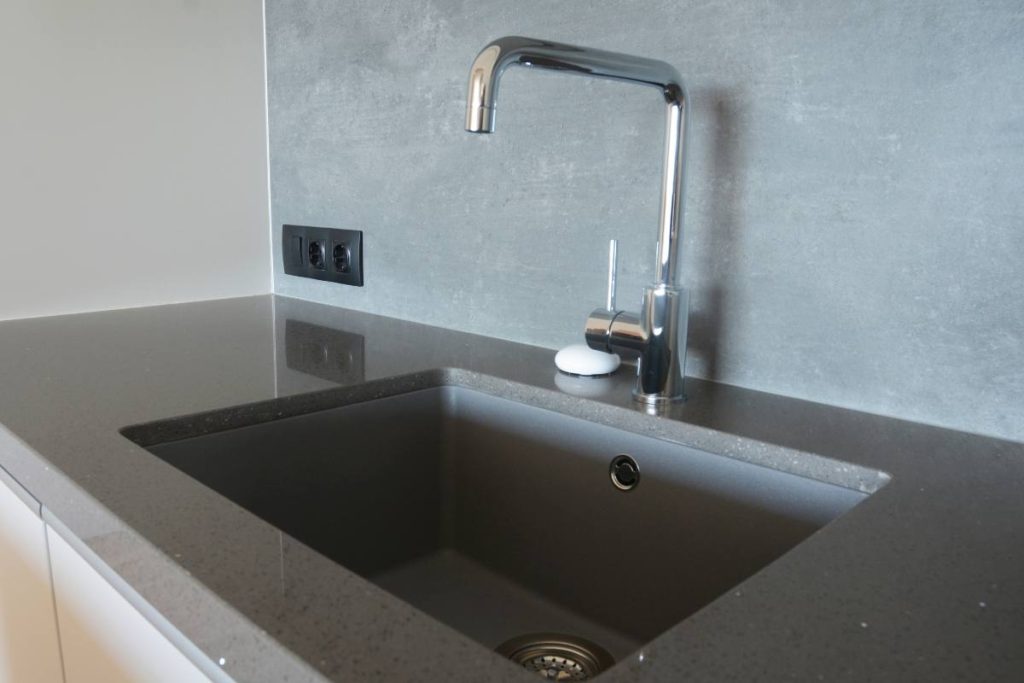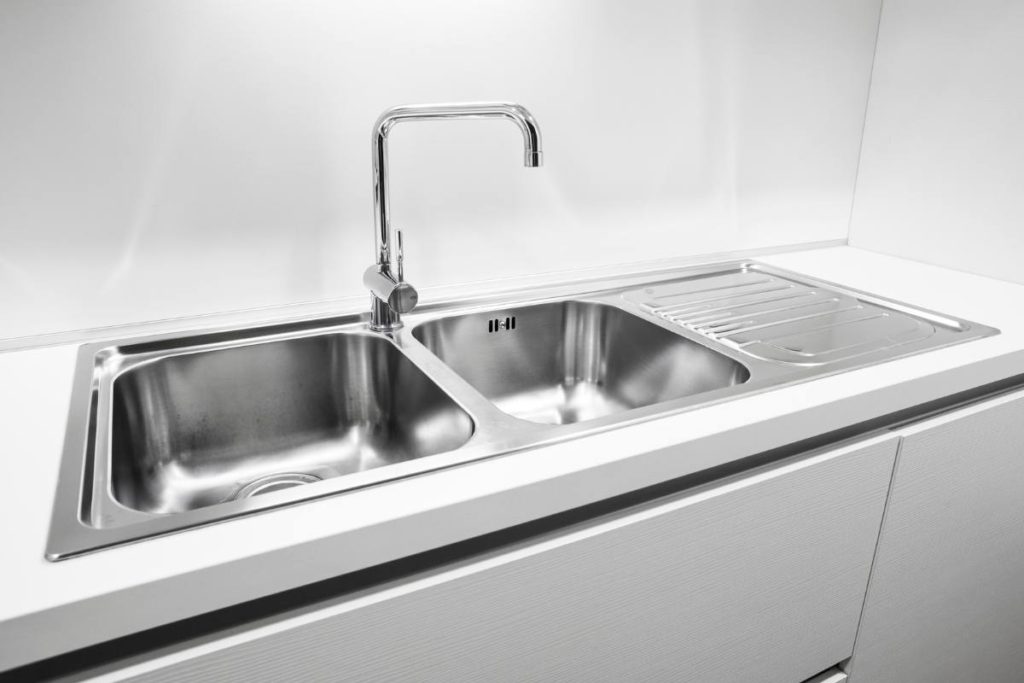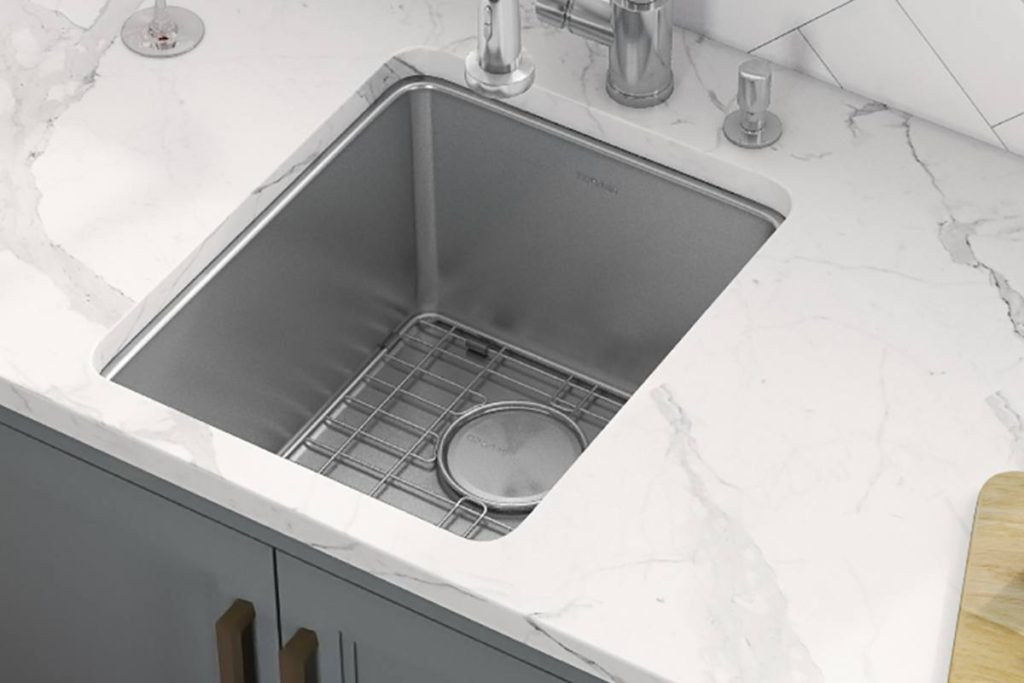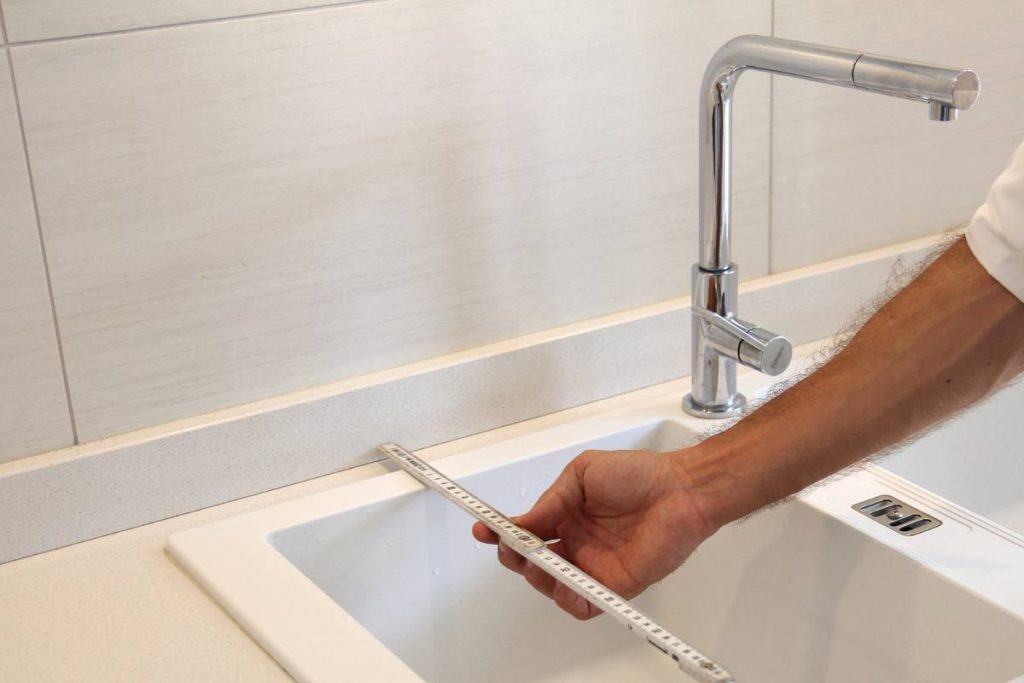Kitchen sink dimensions refer to the size specifications of a sink used for washing dishes and food preparation in a kitchen. The dimensions typically include the sink’s length, width, and depth. The length is the measurement from one end to the other, the width is the measurement from side to side, and the depth is the measurement from the top of the sink to the bottom.
Kitchen sink sizes range from 22 to 45 inches in length, 18 to 25 inches in width, and 8 to 10 inches in depth. These dimensions ensure the sink can comfortably accommodate various kitchen tasks and fit into most countertop spaces.
Before choosing a kitchen sink, consider the size of the cookware and dishes that will be washed, the kitchen’s layout, and the surrounding countertop. Measure the space and understand the sink’s dimensions to find the perfect fit for a functional and visually pleasing kitchen setup.
Not sure how to pick the perfect size for your kitchen sink? Don’t worry; this content will guide you with all you need to know about kitchen sink dimensions.
Types of Kitchen Sink Sizes
Several types of kitchen sinks are available, each designed to suit different preferences and needs.
Below are some common types of kitchen sinks, along with their typical sizes:
Standard Undermount Kitchen Sink Dimensions

Standard undermount kitchen sink sizes vary slightly based on the manufacturer and region. Still, generally, they fall within the two ranges, including the Single Bowl Undermount Sink and Double Bowl Undermount Sink.
The length of single bowl undermount sinks typically measures 22 by 30 inches. The width varies from 18 to 25 inches, and the depth from 8 to 10 inches.
For the overall sink length of double bowl undermount sinks, you can find options ranging from 30 to 48 inches, the width from 18 to 25 inches, and the depth from 8 to 10 inches.
Remember that these dimensions are approximate and can vary depending on the specific model and brand.
So, when selecting an undermount kitchen sink, it’s essential to measure the available space accurately to ensure it fits properly within the cabinet and countertop.
Additionally, consider your kitchen needs and preferences, such as the size of cookware and dishes you typically use, to choose the most suitable sink size for your daily tasks.
Farmhouse Sink Sizes

The farmhouse sink, also known as the apron-front sink, has a distinct design with a front panel extending beyond the countertop’s edge.
The typical sizes of farmhouse sinks are as follows:
- Single Bowl Sink: The length of a single-bowl farmhouse sink typically ranges from 30 to 36 inches. The width can vary from 20 to 22 inches, and the depth is usually around 8 to 10 inches.
- Double Bowl Sink: Double-bowl farmhouse sinks have two basins, and their overall length can range from 30 to 48 inches. The width usually follows the same range as single-bowl sinks (20 to 22 inches), and the depth is similar at 8 to 10 inches.
These are standard sizes, and you may find some farmhouse sinks that deviate slightly from these ranges based on the manufacturer or specific model.
The installation of farmhouse sinks often requires custom cabinetry modifications due to their unique design, so professional installation is recommended for a seamless fit and finish.
Drop-in Kitchen Sink Sizes

Top-mount sinks, or drop-in kitchen sinks, are installed by dropping them into a hole cut into the countertop, and their rim sits on top of the counter.
The typical sizes of drop-in kitchen sinks are as follows:
- Single Bowl Drop-In Sink: The length of a single-bowl drop-in sink typically ranges from 22 to 30 inches. The width can vary from 18 to 25 inches, and the depth is usually around 8 to 10 inches.
- Double Bowl Drop-In Sink: Double-bowl drop-in sinks have two basins, and their overall length can range from 30 to 48 inches. The width usually follows the same range as single-bowl sinks (18 to 25 inches), and the depth is similar at 8 to 10 inches.
- Triple Bowl Drop-In Sink: Triple Bowl sinks offer three basins for added functionality. The length can range from 30 to 48 inches, while the width typically falls within 20 to 25 inches, and the depth is around 8 to 10 inches.
When choosing drop-in sinks, consider the available space in your kitchen and the size of your countertop, and check the manufacturer’s specifications for precise measurements before making a purchase.
Other Types of Kitchen Sinks

- Bar/Prep Sink: Smaller in size, these sinks are designed for use in bars or as secondary sinks. Typical dimensions range from 15 to 25 inches in length, 15 to 18 inches in width, and 6 to 8 inches in depth. In other words, these are the petite-inch sink or the shallow sink.
- Corner Sink: These sinks are designed to fit in the corner of the kitchen to maximize counter space. Dimensions can vary, but typical corner sinks are around 32 inches in length and width, with similar depths to single or double bowl sinks.
If you intend to upgrade your existing sink with smaller or larger alternatives, these options mentioned above can be handy.
Comparison Chart For Kitchen Sink Sizes
| Type | Size | Dimensions |
|---|---|---|
| Standard Undermount | 32 inches | 19 x 32 x 10 inches |
| Farmhouse | 33 inches | 36 x 25 x 14 inches |
| Drop-in | 33 inches | 33 x 22 x 10 inches |
| Top Mount | 31 inches | 31 x 20 x 10 inches |
| Corner Sink | 30 inches | 27 x 30 x 17 inches |
| Bar/Prep | 15 inches | 15 x 19 x 10 inches |
Why Consider Size When Choosing a Kitchen Sink?
Considering the size when choosing a kitchen sink is essential for several practical and functional reasons ranging from fit and installation to compatibility.
Here are some reasons the size of a kitchen sink is considered to pick the right one:
Fit and Installation
Kitchen sinks come in various sizes, and selecting one that fits within the available space in your kitchen is vital. If the sink is too large for the countertop or cabinet, it will be challenging to install, and you may need to make costly modifications to accommodate it properly.
Functionality
The size of a kitchen sink directly impacts its functionality. A sink that is too small may not have enough space to handle larger pots, pans, and dishes. On the other hand, a sink that is too big may waste valuable countertop space or make it difficult to reach items on the other side.
Comfort and Ergonomics
The right kitchen sink size ensuresf comfort and ease of use. It should allow you to wash, rinse, and clean dishes without straining or bending excessively.
Water Usage and Cleaning
An appropriately sized sink can help optimize water usage. A sink that matches your needs allows you to efficiently clean dishes without wasting water. Additionally, cleaning the sink itself becomes more manageable when it’s an appropriate size.
Aesthetics and Design
Kitchen sinks are prominent features in a kitchen, and choosing the right size ensures it complements the overall design and aesthetics of the space.
Cabinet and Countertop Compatibility
The sink size should align with the cabinet and countertop dimensions or the counter space it will be installed in or on. This ensures a seamless fit and enhances the visual appeal of the kitchen.
Plumbing Considerations
The size of a kitchen sink may impact the plumbing setup of the kitchen. An oversized sink might require adjustments to plumbing lines, which could add to the installation complexity and cost.
By considering the size of the kitchen sink, you can create a functional, efficient, and visually pleasing workspace in your kitchen.
Tips for Choosing a Perfect Kitchen Sink
Choosing the perfect kitchen sink is a significant decision that can greatly impact your daily kitchen experience.
Here are some useful tips to help you make the right choice:
Consider Sink Material
Kitchen sinks come in various materials, including stainless steel, cast iron, granite composite, fireclay, and more. Each material has its advantages and disadvantages in terms of durability, appearance, and maintenance. Choose a material that suits your style, budget, and cleaning preferences.
Think about Sink Size
Consider the available space in your kitchen and the size of your countertop when choosing a sink. Measure the area carefully and select a sink that fits comfortably without wasting valuable counter space.
Single or Double Sink Basin
Decide whether you prefer a single or double sink. Single-bowl sinks offer more space for large items, while double-bowl sinks allow for multitasking and separating tasks.
Installation Type
Determine whether you want an undermount, drop-in (top-mount), or farmhouse sink. The installation type affects the aesthetics and functionality of the sink.
Depth of the Sink
The depth of the sink impacts its usability. Deeper sinks can handle larger pots and dishes, but shallow sinks may be more comfortable for shorter individuals.
Style and Design
Choose a sink that complements the overall design and aesthetics of your kitchen. Consider the sink’s shape, color, and finish to match your kitchen decor.
Quality and Durability
Invest in a high-quality sink that will withstand daily use and last for years without showing wear and tear. Advisably, consider stainless still sinks.
Easy to Clean
Look for a sink that is easy to clean and maintain. Smooth, non-porous surfaces are generally easier to clean and resist stains.
Budget
Set a budget for your kitchen sink and stick to it. Sinks are available in various price ranges, so you can find one that fits your budget without compromising on quality.
Warranty and Customer Reviews
Check the warranty offered by the manufacturer and read customer reviews to get insights into the sink’s performance and longevity.
Considering these tips and thoroughly researching your options, you can select the perfect kitchen sink that enhances your kitchen’s functionality and aesthetics while staying within your budget.
How to Measure the Dimensions of a Kitchen Sink?
Measuring the dimensions of a kitchen sink is a straightforward process.

Follow these steps to accurately measure the length, width, and depth of the sink:
- Clear the sink area, and remove any dishes, utensils, or accessories to ensure a clear measuring space.
- Use a tape measure to measure the sink’s length, width, and depth from one end to the other.
- Note down the measurement in inches or centimeters.
- If you have a double or triple bowl sink, you can measure the dimensions of each bowl individually using the same process as above.
- If you have a drop-in sink, consider the dimensions of the rim as well, especially if you’re planning to replace the sink.
- Measure the outer dimensions of the sink, including the rim that rests on the countertop.
- Ensure you take precise measurements to ensure the new sink fits properly within the existing cabinet and countertop space.
Always double-check your measurements to avoid any errors before making a purchase.
FAQs
What’s the standard size for a kitchen sink?
The standard size for a kitchen sink can vary slightly, but a typical single-bowl kitchen sink is approximately 22 to 30 inches long, 18 to 25 inches wide, and 8 to 10 inches deep.
For a standard double-bowl kitchen sink, the overall length can range from 30 to 48 inches, with each bowl measuring around 14 to 18 inches in width and 8 to 10 inches in depth.
What size kitchen sink can fit in a 30 cabinet?
A kitchen sink that fits into a 30-inch cabinet typically has a width of approximately 27 inches. This leaves a small gap on either side of the sink within the cabinet to allow for proper installation.
Since the actual size of the sink may vary slightly depending on the specific model and manufacturer, it’s advisable to check the sink’s specifications before purchasing.
What size sink do I need for a 32-inch cabinet?
For a 32-inch cabinet, the recommended size for a kitchen sink is typically around 30 inches in width. This also allows for a comfortable fit within the cabinet while leaving a small gap on either side for installation.

Kitchen sink dimensions vary depending on the type and configuration, such as single-bowl, double-bowl, and farmhouse sinks.
Accurate measurements and consideration of your kitchen needs will help ensure the sink fits properly within the available space and provides the desired functionality.
Factors like sink material, installation type, and style should be carefully considered during the selection process.









